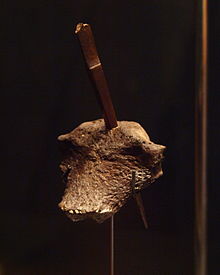Man of Porsmose
The man of Porsmose is a jungneolithische bog body , which in 1946 in Næstved on the Danish island of Zealand was found. The man was killed by several arrow hits. The remains of the Man of Porsmose are kept in the National Museum of Denmark .
Location: 55 ° 16 ′ 35.1 ″ N , 11 ° 52 ′ 29.8 ″ E
Finding
The skull and various bones of the skeleton were recovered from the approximately 35-year-old man, the soft tissues were gone. The preserved parts of the dentition show severely chewed teeth.
The man was killed by several arrow shots, as evidenced by two preserved arrowheads in the bones. Both arrowheads are made of bone, have a rectangular cross-section with strongly offset shaft tongues for insertion into the arrow shafts. An arrowhead 105 mm long hit the man in the face. Coming steeply from above, the arrow penetrated the right nostril into the palate area and penetrated the right palatine bone . The tip got stuck there and protruded 45 mm into the oral cavity. This injury in itself was not fatal and the man could have survived it for a long time. The other arrow hit was fatal. This pierced the man's upper sternum and most likely injured his main artery . The arrowhead, 127 mm long, got stuck in the upper sternum. Both arrows are believed to have been shot at close range. The man's corpse must then have ended up in an open lake, which silted up into a moor after the soft tissues had already largely rotted away.
The radiocarbon dating of the bones revealed a time of death of 4710 ± 90 BP that corresponds to a calibrated calendar age of 3499 ± 105 v. According to the 14 C dating, the man can be assigned to the Middle Neolithic Funnel Beaker Culture (TBK). According to the description in the Danish National Museum, however, the type of bony tip corresponds to the end-Neolithic individual grave culture .
Human sacrifices are documented from the beginning of the Neolithic (in the north from 4000 BC) to the end of the Iron Age (500 AD) and were recovered from northern moors.
See also
literature
- Pia Bennike, Klaus Ebbesen: The bog find from Sigersdal . In: Journal of Danish Archeology . No. 5 , 1986, ISSN 0108-464X , pp. 85-115 (English).
- Wijnand van der Sanden : Mummies from the moor. The prehistoric and protohistoric bog bodies from northwestern Europe . Batavian Lion International, Amsterdam 1996, ISBN 90-6707-416-0 , pp. 88, 161, 177, 225 (Dutch, original title: Vereeuwigd in het veen . Translated by Henning Stilke).
- Göran Burenhult (ed.): The people of the Stone Age - hunters, gatherers and early farmers . Augsburg 2000, ISBN 3-8289-0742-3 .
- CJ Becker : Skeletons found from Porsmose ved Næstved . In: National Museum Arbejdsmark . National Museum of Denmark, 1952, ISSN 0084-9308 , p. 25-30 (Danish).
Web links
- Porsmose skull with arrow shot injury. In: Exhibition: climate and people. LWL Museum of Archeology, accessed December 6, 2011 (photo of the skull).
Individual evidence
- ↑ http://www.kulturarv.dk/fundogfortidsminder/Lokalitet/89630/
- ^ Wijnand van der Sanden : Mummies from the moor - The prehistoric and early historical moor corpses from northwestern Europe . Drents Museum / Batavian Lion International, Amsterdam 1996, ISBN 90-6707-416-0 , p. 194 (Dutch: Vereeuwigd in het veen .).
- ↑ Calibration with CalPal Online
- ^ Weapons, violence and death in the Neolithic period. (No longer available online.) National Museum of Denmark , archived from the original on October 7, 2011 ; accessed on December 6, 2011 (English, description of the find with illustrations). Info: The archive link was inserted automatically and has not yet been checked. Please check the original and archive link according to the instructions and then remove this notice.
| personal data | |
|---|---|
| SURNAME | Man of Porsmose |
| BRIEF DESCRIPTION | Bog corpse |
| DATE OF BIRTH | around 3500 BC Chr. |
| DATE OF DEATH | around 3500 BC Chr. |
| Place of death | near Næstved , Denmark |

